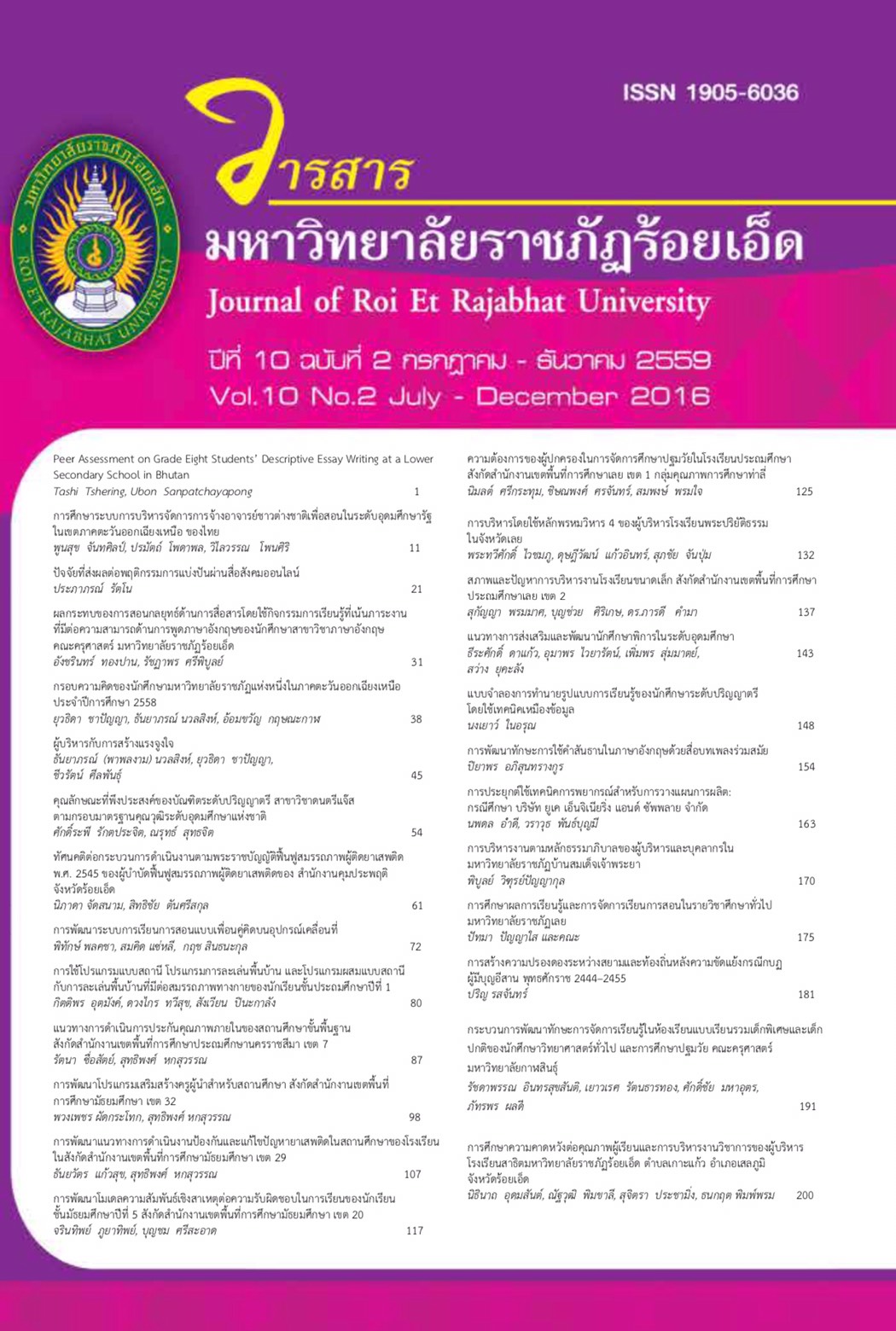Development of a Causal Relationship Model with Learning Responsibilities of Matthayomsueksa 5 Students under the Secondary Education Service Area Office 20
Keywords:
Development, A Causal Relationship Model, Structural Equation ModelAbstract
This study aimed to 1) identify the causal relations between the variables influencing learning responsibilities of Matthayomsueksa 5 (grade 11) students under the Secondary Education Service Area Office 20, and 2) examine the goodness of fit of the model developed of the cause relationships among the variable influencing learning responsibilities of the sample.
The sample used in this study consisted of 460 Matthayomsueksa 5 students in the second semester of the academic year 2015 using the multi–stage random sampling technique. The instruments used in the study were 5–rating–scale inventories. They included a 20–item test on learning responsibilities, a 20–item test on future orientation characteristics, a 30–item test on self– concept, a 20–item test on achievement motive and a 20–item test on attitude toward studying, with discriminating powers ranged (rxy) from .205 to .543, .283 to .728, .212 to .698, .235 to .702 and .232 to .741 respectively and reliabilities () of 0.733, 0.897, 0.839, 0.894 and 0.898 respectively. Data analyses employed were descriptive statistics, Confirmatory Factor Analysis (CFA Structural Equation Model (SEM) using Mplus 7 computer program.
The result of study were as follows : The development and goodness of fit test result of a causal relationship model with learning revealed that the model was consistent with the empirical data at a high level tested by the index statistic test of the consistency = 80.612, df = 66,
/df = 1.22, P–Value = 0.1065, CFI = 0.996, TLI = 0.993, RMSEA = 0.022 and SRMR = 0.046. The variance with the highest direct influencing on the learning responsibilities was latent variance of self–concept (SEL), latent variance of attitude toward studying (ATT), latent variance of achievement motive (MOT) and latent variance of future orientation characteristics (FUO) respectively. It was revealed that the model co– factor explained the variance of the learning responsibilities at 63.9 percent.
References
เกษม วัฒนชัย. (2539). ความคาดหวังของพ่อแม่ต่อการศึกษาของลูก. กรุงเทพฯ : มหาวิทยาลัยมหิดล.
จรรยา สุวรรณทัต. (2531). เยาวชนไทยกับการมุ่งอนาคต. กรุงเทพฯ : สถาบันวิจัยพฤติกรรมศาสตร์ มหาวิทยาลัย ศรีนครินทรวิโรฒ ประสานมิตร.
จำรูญ เทียมธรรม. (2546). การศึกษาความสัมพันธ์ระหว่างปัจจัยบางประการกับแรงจูงใจใฝ่สัมฤทธิ์ทางการศึกษาของนักเรียนชั้นมัธยมศึกษาปีที่ 4. ปริญญานิพนธ์ กศ.ม. กรุงเทพฯ : มหาวิทยาลัยศรีนครินทรวิโรฒ ประสานมิตร,.
ดาริณี วงษ์อยู่น้อย. (2535). การพัฒนาแรงจูงใจใฝ่สัมฤทธิ์โดยใช้วิธีการให้คำปรึกษาแบบกลุ่ม. ปริญญานิพนธ์ กศ.ม. กรุงเทพฯ : มหาวิทยาลัยศรีนครินทรวิโรฒ ประสานมิตร.
ทิศนา แขมมณี. (2526, ตุลาคม–ธันวาคม). “การสอนเพื่อเสริมสร้างอัตมโนทัศน์ตามแนวมนุษย์นิมนวกรรมการศึกษาระดับประถมศึกษา,” วารสารครุศาสตร์. 12 : 12–19.
เนตรชนก พุ่มพวง. (2546). ตัวแปรที่เกี่ยวข้องกับ ลักษณะมุ่งอนาคตของนักเรียนชั้นมัธยมศึกษาตอนปลาย โรงเรียนราชวินิตบางแก้ว อำเภอบางงพลีจังหวัดสมุทรปราการ. ปริญญานิพนธ์ กศ.ม. กรุงเทพฯ : มหาวิทยาลัยศรีนครินทรวิโรฒ ประสานมิตร.
ปิยกาญจน์ กิจอุดมทรัพย์. (2540). ตัวแปรที่เกี่ยวข้องกับลักษณะมุ่งอนาคตของนักศึกษาหลักสูตรวิชาชีพระยะสั้น วิทยาลัยสารพัดช่าง กรุงเทพมหานคร. ปริญญานิพนธ์ กศ.ม. (จิตวิทยาการศึกษา). กรุงเทพฯ : มหาวิทยาลัย ศรีนครินทรวิโรฒ ประสานมิตร.
พรรณี ช. เจนจิต. (2538). จิตวิทยาการเรียนการสอน. กรุงเทพฯ : ต้นอ้อแกรมมี่.
มะลิ อุดมภาพ. (2538). การศึกษาหาความสัมพันธ์ระหว่างปัจจัยบางประการกับความภาคภูมิใจในตนเองของนักเรียนชั้นมัธยมศึกษาปีที่ 3. ปริญญานิพนธ์ กศ.ม. กรุงเทพฯ : มหาวิทยาลัยศรีนครินทรวิโรฒ ประสานมิตร.
รุ่งนภา ทีฆะ. (2522). ความสัมพันธ์ระหว่างอัตมโนทัศน์ความเชื่ออำนาจภายในภายนอกตน และสัมฤทธิ์ผลทางการเรียน. วิทยานิพนธ์ ค.ม. กรุงเทพฯ : จุฬาลงกรณ์มหาวิทยาลัย.
สมพร เทพสิทธา. (2540). การส่งเสริมศาสนาและจิรยธรรมในยุคโลกาภิวัตน์. กรุงเทพฯ : สถาบันสังคมสงเคราะห์แห่งประเทศไทย ในพระบรมราชูปถัมภ์.
สมโภชน์ เอี่ยมสุภาษิต. (2541). ทฤษฎีและเทคนิคการปรับพฤติกรรม. กรุงเทพฯ : สำนักพิมพ์จุฬาลงกรณ์มหาวิทยาลัย.
สิรภัทร ขจรสมบัติ. (2553). การเปรียบเทียบความรับผิดชอบต่อการเรียน ความซื่อสัตย์ของนักเรียนชั้นมัธยมศึกษาปีที่ 2 ที่มีการอบรมเลี้ยงดู และลักษณะมุ่งอนาคตแตกต่างกัน. ปริญญานิพนธ์ กศ.ม. มหาสารคาม : มหาวิทยาลัยมหาสารคาม.
สุภาภรณ์ ศศิดิลกธรรม. (2543). ตัวแปรที่เกี่ยวข้องกับความอุตสาหะในการเรียนของนักเรียนชั้นประถมศึกษาปีที่ 6 สังกัดสำนักงานประถมศึกษาจังหวัดสระบุรี. ปริญญานิพนธ์ กศ.ม. กรุงเทพฯ : มหาวิทยาลัยศรีนครินทรวิโรฒ ประสานมิตร.
สุรางค์ โค้วตระกูล. (2544). จิตวิทยาการศึกษา. กรุงเทพฯ : สำนักพิมพ์แห่งจุฬาลงกรณ์มหาวิทยาลัย.
Lamm, H., Schmidt, R.W., & Trommsdorff. (1976). “Sex and Social Lass as Determinants of Future Orientation in Adolescent,” Journal of Personality and Social Psychology. 34(3) : 317–326.
Downloads
Published
How to Cite
Issue
Section
License
บทความที่ได้รับการตีพิมพ์เป็นลิขสิทธิ์ของวารสารมหาวิทยาลัยราชภัฎร้อยเอ็ด
ข้อความที่ปรากฏในบทความแต่ละเรื่องในวารสารวิชาการเล่มนี้เป็นความคิดเห็นส่วนตัวของผู้เขียนแต่ละท่านไม่เกี่ยวข้องกับมหาวิทยาลัยราชภัฎร้อยเอ็ด และคณาจารย์ท่านอื่นๆในมหาวิทยาลัยฯ แต่อย่างใด ความรับผิดชอบองค์ประกอบทั้งหมดของบทความแต่ละเรื่องเป็นของผู้เขียนแต่ละท่าน หากมีความผิดพลาดใดๆ ผู้เขียนแต่ละท่านจะรับผิดชอบบทความของตนเองแต่ผู้เดียว





